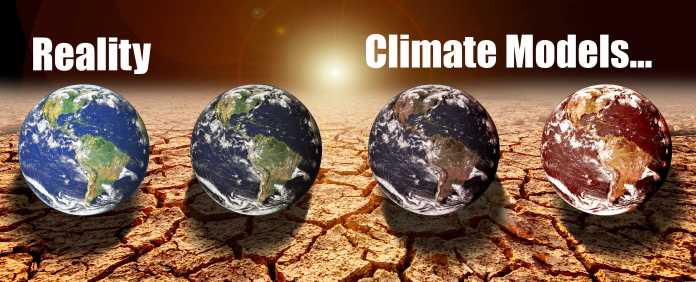Climate scientists and climate modelers recently admitted the newest, sixth generation of climate models (CMIP6), particularly its high emissions scenario, Representative Concentration Pathway 8.5 (RCP8.5) produce “implausibly hot forecasts of future warming.”
Two peer-reviewed papers from independent teams confirm that climate models overstate atmospheric warming and illustrate that the problem has gotten worse over time, not better.
The papers are Mitchell et al. (2020) “The vertical profile of recent tropical temperature trends: Persistent model biases in the context of internal variability” in Environmental Research Letters, and McKitrick and Christy (2020) “Pervasive warming bias in CMIP6 tropospheric layers” in Earth and Space Science.
McKitrick and Christy write:
- “…we find considerable warming biases in the CMIP6 modeled trends, and we show that these biases are linked to biases in surface temperature (these models simulate an unrealistically large global warming).”
- “…we note here for the record that from 1998 to 2014, the CMIP5 models warm, on average 4 to 5 times faster than the observations, and in one model the warming is 10 times larger than the observations.”
- “Throughout the depth of the troposphere, not a single model realization overlaps all the observational estimates. However, there is some overlap between the RICH observations and the lowermost modelled trend, which corresponds to the NorCPM1 model.”
- “Focusing on the CMIP6 models, we have confirmed the original findings of Mitchell et al. (2013): first, the modeled tropospheric trends are biased warm throughout the troposphere (and notably in the upper troposphere, around 200 hPa) and, second, that these biases can be linked to biases in surface warming. As such, we see no improvement between the CMIP5 and the CMIP6 models.” (Mitchell et al. 2020)
Mitchell, et al. write:
- “As in earlier studies, we find considerable warming biases in the CMIP6 modeled trends, and we show that these biases are linked to biases in surface temperature.”
- “We also uncover previously undocumented biases in the lower-middle stratosphere: the CMIP6 models appear unable to capture the time evolution of stratospheric cooling,…”
- “Finally, using models with large ensembles, we show that their standard deviation in tropospheric temperature trends, which is due to internal variability alone, explains ∼ 50% (± 20%) of that from the CMIP6 models.”
Modeling the climate is incredibly difficult, requiring massive computing power. But, since problems with the CMIP6 models have been recognized by others for more than two years, what we are really dealing with here is GIGO – garbage in, garbage out – based on the confirmation bias of the people creating the climate models.
The U.N. Intergovernmental Panel of Climate Change (IPCC) has refused to change course or alter its publication timelines despite the recognized failures of the models their report relies upon. In addition, an unquestioning media reports IPCC’s most alarming scenarios based on these flawed models. As a result, many people are all living with the fear and loathing of alarming weather predictions. Yet these predictions, are grounded in models which project far too much warming, based on an inaccurate assessment of the earth’s climate sensitivity to increased carbon dioxide in our atmosphere, and IPCC representatives and modelers highlighting grossly exaggerated forcing scenarios, RCP8.5, concerning the amount of carbon dioxide likely to enter the atmosphere.
The bottom line is that the future isn’t being accurately represented to us by most climate scientists or their media lapdogs.
Science is supposed to be self-correcting. However, getting activists and scientists that rely on future alarm as part of their paycheck to pay attention to what science actually says, versus what they believe will really happen in their dire vision of the future, is a much tougher problem.
As Upton Sinclair once famously said:
“It is difficult to get a man to understand something, when his salary depends on his not understanding it.”

















